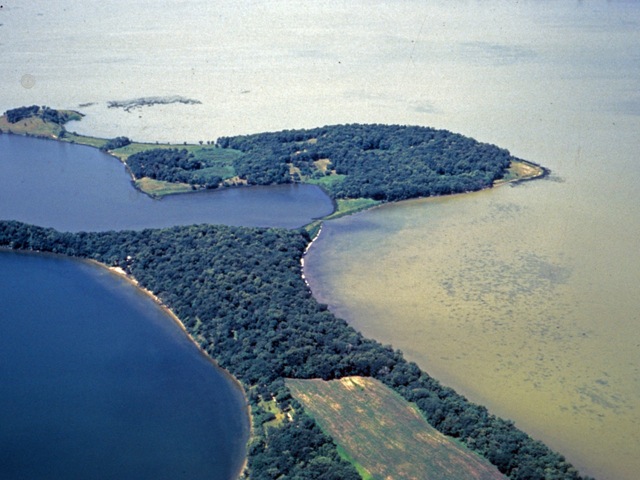Mud manifests history of clear water in murky Minnesota duck depot Lake Christina
Implications for ducks, fish, and landscape management
 During peak migration days in the early 1900s, tens of thousands of canvasback ducks could be seen floating and diving on Minnesota’s Lake Christina. Since midcentury, changes to the lake have diminished this grand, iconic spectacle. Restoring it will require both top-down control of life in the lake, and bottom-up management of the surrounding landscape. So says a team of Minnesota scientists calling on extensive modern records and 200 years of history trapped in sediment, in a report released online last week in the journal Ecological Applications.
During peak migration days in the early 1900s, tens of thousands of canvasback ducks could be seen floating and diving on Minnesota’s Lake Christina. Since midcentury, changes to the lake have diminished this grand, iconic spectacle. Restoring it will require both top-down control of life in the lake, and bottom-up management of the surrounding landscape. So says a team of Minnesota scientists calling on extensive modern records and 200 years of history trapped in sediment, in a report released online last week in the journal Ecological Applications.
“Lake Christina is very important for the region culturally, and ecologically,” said Will Hobbs, a scientist at the Science Museum of Minnesota and lead author of the report. “The lake is a significant stop-over for waterfowl migrating along the Mississippi Flyway, but it has been compromised since the 1950s.”
Lake Christina has an unusually long history of management, offering a unique opportunity to study the effects of biological manipulations and management.
In the 1950s, the lake’s clear water darkened to a green algal soup. By calibrating sediment cores to 25 years of modern records, the research team learned that Lake Christina had had clear waters for 100 years prior to European settlement in the late nineteenth century – the clear water was a stable state, and not an historical aberration. But now the lake is in a stable, murky state.
Managers have been struggling to regain clear waters in the lake for migrating waterfowl, particularly the big, rusty-headed canvasbacks. The ducks need a healthy meal of submerged aquatic plants to fuel their journey, but the dense algae blocks out so much sunlight that underwater plants like sago pondweed and wild celery can’t grow.
A similar loss of submerged aquatic plants has developed at the canvasbacks’ major historic wintering grounds on Chesapeake Bay.
“Life is not easy for a duck. You need those areas where you can stop and rest – large open expanses of shallow water with readily available food,” said author Mark Hanson, a research scientist with the Minnesota Department of Natural Resources.
Two factors led to the clouding of the waters: an influx of nutrients from agriculture fed the algae, and a dam built in 1936 led to a fall in the population of tiny, algae-eating zooplankton. The dam doubled the depth of the lake, from two feet to four, allowing fish that eat zooplankton to survive the winter, and thrive.
To make the lake attractive for ducks, managers killed most of the fish in 1965, 1987, and 2003, each time achieving only temporary success. Within a decade, the fish recovered, and the algae followed.
Restoration of wetlands surrounding the lake has not, as yet, met hopes for lowered nutrient levels.
“It’s very difficult to get the nutrients out of the lake,” said author Kyle Zimmer, an associate professor at the University of St. Thomas who has studied the fish at Lake Christina for several years. “We know from the literature that these things can take time, and maybe top-down, active management allows that time, or at least simulates the outcome we want, even if a self-maintained stable state is not achieved.”
Managers walk a fine line, balancing short and long term needs, and balancing the interests of ducks and duck hunters at Lake Christina with those of recreational anglers. This fall, top-down management will include a series of pumps and pipes installed to draw-down the water level, mimicking the natural winter fish kill.
“The study presents compelling evidence that, in the long run, managers need to focus on strategies that target landscapes, not just the food webs in the lakes themselves – bearing in mind that the short term is also important,” said Hanson. “The people that live here today are very much in this culture of ducks and migratory water birds, and the incredible history around them. When we get all sectors working on lake ecology together, that’s a very productive basis for the future.”
“A 200-year perspective on alternative stable state theory and lake management from a biomanipulated shallow lake” was published online, ahead of print, on 19 March 2012. It is slated for the July edition of Ecological Applications. doi: 10.1890/11-1485.1. To obtain a pdf, or associated images, contact Liza Lester.
Students at North Dakota State University, in collaboration with the Minnesota Department of Natural Resources, contributed significant contemporary data to this project from long term monitoring efforts at Lake Christina.
PHOTO: Turbid Lake Christina in the early 1980s, flanked on the left by two smaller, clear lakes. Courtesy of Thomas Carlson, Minnesota Department of Natural Resources.